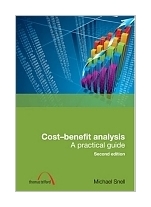|
||
• wydawnictwa polskie
• Zamów informacje o nowościach z wybranego tematu • kontakt
• Cookies na stronie |
COST-BENEFIT ANALYSISSNELL M.wydawnictwo: THOMAS TELFORD , rok wydania 2010, wydanie IIcena netto: Now part of the ICE manuals series, ICE manual of construction law is the essential legal reference for all construction professionals. Written for non-lawyers by experts from the largest specialist construction law firms and leaders from within the construction industry, ICE manual of construction law considers the practical and commercial implications of case law and legislation and delivers practical guidance and a breadth of knowledge that is unrivalled by any other publication. Covering current UK and European legislation, the most important construction law issues are addressed as they may arise on a project from planning, financing and procurement, through operational issues and general law, such as insurance, employment, contracts, health and safety, environmental issues, to construction disputes and dispute resolution. Table of Contents
Preface to the first edition ix Preface to the second edition xi Introduction xiii 1 Basic principles of cost-benefit analysis 1 1.1 A set of tools for guiding decisions 1 1.2 A common unit of measurement 2 1.3 Types of cost-benefit analysis 3 1.4 The decision-making context 6 1.5 Value judgements 7 1.6 Analysts, decision-makers and transparency 7 1.7 Risk, uncertainty and pragmatism 8 1.8 Stages of the planning-design-implementation process 8 1.9 The main stages of a cost-benefit analysis 10 Notes 11 2 Quantifying and valuing the costs and benefits 13 2.1 Costs and benefits in the with-project and without-project situations 13 2.2 Costs and benefits that are sometimes not counted 16 2.3 Defining the common unit of measurement 24 2.4 Shadow pricing: practical application 26 2.5 Rationale of shadow pricing 28 2.6 Valuation of particular kinds of costs and benefits 31 2.7 Double-counting 36 Notes 38 3 Resources and time: discounting and indicators 40 3.1 Time preference 40 3.2 Discounting 42 3.3 Indicators and their calculation 46 3.4 Length of analysis period 52 3.5 Inflation, depreciation and loans 54 3.6 Choice of indicator for particular purposes 57 3.7 Sensitivity tests 61 3.8 Terminology and reporting 66 3.9 The appropriate discount rate 68 Notes 75 4 Application to particular fields 78 4.1 General 78 4.2 Agriculture 82 4.3 Health projects and programmes 90 4.4 Water supply, sanitation, public health 94 4.5 Education 96 4.6 Flood and coastal protection, environment, recreation 98 4.7 Transport 111 4.8 Energy 115 4.9 Urban and regional planning 117 Notes 117 5 Reporting and presentation 120 5.1 Definition of the project 122 5.2 Methodology and assumptions 123 5.3 Statement of price basis 123 5.4 Probabilistic aspects of benefit estimates 124 5.5 Treatment of sensitive demand forecasts 125 5.6 Optimisation of timing 125 5.7 Financial analysis 127 5.8 Size optimisation and choice of indicator 128 5.9 Graphical presentation of sensitivity test results 129 5.10 Sensitivity tests in text 131 5.11 Summary 133 Note 133 6 Checklist 134 Appendices 139 A Uncertainty, probability and risk 141 A.1 Basic concepts 141 A.2 Attitudes to uncertainty 149 A.3 Ways of handling uncertainty in CBA 153 A.4 Summary and recommendations 159 A.5 Further reading and information sources 159 Notes 160 B The domestic pricing and foreign exchange numéraires 163 B.1 Introduction 163 B.2 Traded and non-traded goods 164 B.3 The domestic pricing system 164 B.4 The foreign exchange system 165 B.5 Comparison of the two systems 166 B.6 Choice of system 167 B.7 Further reading and information sources 169 Notes 170 C Ways of estimating economic prices 172 C.1 Introduction and underlying principles 172 C.2 Market prices with adjustments 175 C.3 Opportunity cost approaches 178 C.4 Stated preferences; contingent valuation 182 C.5 Proxy markets and other revealed-preference approaches 184 C.6 Shadow pricing as an instrument of policy 188 C.7 Choice of valuation method 188 C.8 Benefit transfer 189 C.9 Further reading and information sources 190 Notes 191 D Distribution of costs and benefits between people 195 D.1 General distribution adjustments 195 D.2 Income w8 ing 196 D.3 Use of distributional w8 ing 198 Notes 198 E Choice of discount rate 200 E.1 Introduction 200 E.2 Individual and social time preference 201 E.3 Opportunity cost of capital 202 E.4 Capital rationing device 203 E.5 Risk and the discount rate 204 E.6 Synthesis 205 E.7 Further reading and information sources 207 Notes 209 F Multicriterion decision analysis 212 F.1 Introduction 212 F.2 Basic concepts and techniques 214 F.3 Non-numerical methods 220 F.4 A simple numerical method 221 F.5 Other methods 225 F.6 Uncertainty and incomplete information 229 F.7 Further reading and information sources 229 Notes 230 G The effects method 232 Notes 233 H Model answers to readers' worked examples 235 I Worked example 241 I.1 Introduction 241 I.2 The project 241 I.3 Economic prices 243 I.4 Farm level financial analysis 245 I.5 Economic benefits 246 I.6 Economic costs 249 I.7 Cost-benefit indicators 250 I.8 Sensitivity tests 251 I.9 Conclusion 253 I.10 Postscript 254 J Discounting tables 256 K Bibliography 267 Glossary/index 281 312 pages, Hardcover Księgarnia nie działa. Nie odpowiadamy na pytania i nie realizujemy zamówien. Do odwolania !. |


